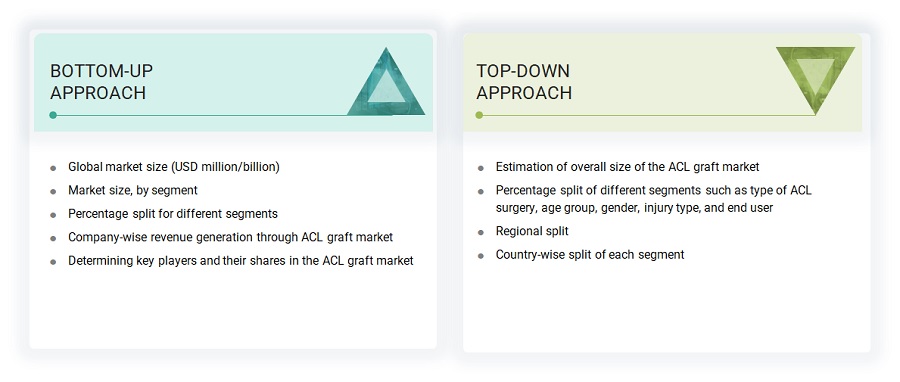To determine the current size of the ACL graft market, this study engaged in four main activities. A comprehensive study was conducted using secondary research methods to gather data about the market, its parent market, and its peer markets. The next stage involved conducting primary research to confirm these conclusions, assumptions, and sizing with industry experts throughout the value chain. A combination of top-down and bottom-up methods was used to assess the overall market size. The market sizes of segments and subsegments were then estimated using data triangulation techniques and market breakdown.
The four steps involved in estimating the market size are
Collecting Secondary Data
Within the secondary data collection process, a range of secondary sources were reviewed so as to identify and gather data for this study, including regulatory bodies, databases (like D&B Hoovers, Bloomberg Business, and Factiva), white papers, certified publications, articles by well-known authors, annual reports, press releases, and investor presentations of companies.
Collecting Primary Data
A thorough method was used in the primary research phase, which involved interviewing a wide range of sources from the supply and demand sides. The purpose of these interviews was to obtain the quantitative and qualitative information needed to put up this report. The main sources of information were industry experts from both core and related sectors, as well as preferred manufacturers, distributors, suppliers, pioneers in technology, and organizations involved in every aspect of this industry's value chain. A variety of primary respondents, including important industry stakeholders, subject-matter experts, C-level executives from crucial market companies, and industry advisers, were carefully questioned in-depth. The goal was to gather and validate important qualitative and quantitative insights and to conduct a thorough assessment of future possibilities.
A breakdown of the primary respondents is provided below:

Note 1: Others include sales, marketing, and product managers.
Note 2: Tiers of companies are defined based on their total revenue. As of 2023, Tier 1 = >USD 5 billion, Tier 2 = USD 500 million to USD 5 billion, and Tier 3 = < USD 500 million.
To know about the assumptions considered for the study, download the pdf brochure
|
COMPANY NAME
|
DESIGNATION
|
|
MTF Biologics (US)
|
Area Sales Manager
|
|
AlloSource (US)
|
Area Account Manager
|
|
RTI Surgical (US)
|
Consultant
|
Market Size Estimation
Both top-down and bottom-up approaches were used to estimate and validate the total size of the ACL graft market. These methods were also used extensively to estimate the size of various subsegments in the market. The research methodology used to estimate the market size includes the following:

Data Triangulation
After arriving at the overall market size applying the process mentioned above, the total market was split into several segments and subsegments. To complete the overall market engineering process and arrive at the exact statistics for all segments and subsegments, data triangulation and market breakdown procedures were employed, wherever applicable. The data was triangulated by studying various factors and trends from both the demand and supply sides.
Market Definition
Allograft anterior cruciate ligament reconstruction is a surgical intervention designed to repair a tear in the anterior cruciate ligament (ACL) of the knee, utilizing donor tissue for grafting.
A strip of donated tendon is used during allograft anterior cruciate ligament reconstruction surgery to strengthen the injured ACL. Donated tendons are obtained from deceased individuals who gave their permission for their tendons to be used in a way that benefits others.
Key Stakeholders
-
Manufacturers and Distributors of ACL graft
-
Hospitals
-
Ambulatory Surgery Centers
-
Specialty Clinics
-
Tissue Banks
-
Orthopedic Surgeons and Medical Staff
-
Healthcare Providers
-
Market Research and Consulting Firms
-
Government Associations
-
Venture Capitalists and Investors
Report Objectives
-
To define, describe, segment, and forecast the ACL graft market by type of ACL surgery, age group, gender, injury type, end user, and region
-
To provide detailed information regarding the major factors influencing the market growth (such as drivers, restraints, opportunities, and challenges)
-
To assess the ACL graft market with respect to Porter’s five forces, regulatory landscape, the value chain, the supply chain, ecosystem analysis, patent protection, pricing assessment, key stakeholders, and buying criteria
-
To analyze the micromarkets1 with respect to individual growth trends, prospects, and contributions to the overall ACL graft market
-
To analyze market opportunities for stakeholders and provide details of the competitive landscape for key players
-
To forecast the size of the market segments with respect to six regions, namely, North America, Europe, Asia Pacific, Latin America, the Middle East & Africa, and GCC Countries
-
To profile the key players and comprehensively analyze their product portfolios, market positions, and core competencies
-
To track and analyze company developments such as product launches, product approvals, and other developments
-
To benchmark players within the market using the proprietary Company Evaluation Matrix framework, which analyzes market players on various parameters within the broad categories of business and product excellence
Available Customizations
With the given market data, MarketsandMarkets offers customizations to meet the company’s needs. The following customization options are available for the report:
Geographic Analysis:
Further breakdown of the ACL graft market into specific countries/regions in Europe, Asia Pacific, Latin America, Middle East & Africa, and GCC Countries.
Company Information:
Detailed analysis and profiling of additional market players (up to Five), inclusive of:
-
Business Overview
-
Financial Information
-
Product Portfolio
-
Developments (last three years)
Note: Some companies are privately owned, and their revenues are unavailable in the public domain. Hence, revenues for privately owned companies will not be included in their profile. In addition, company developments that are not reported in the public domain will not be included.



Growth opportunities and latent adjacency in ACL Graft Market